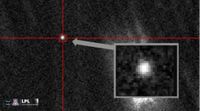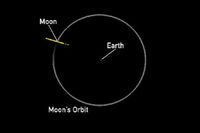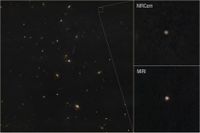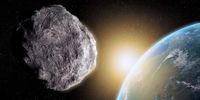A “city-killer” asteroid previously thought to be on a collision course with Earth could smash into the Moon instead, new data suggests. Asteroid 2024 YR4 caused global concern after its discovery last year as the space rock’s trajectory indicated a 3 percent chance of it crashing into the Earth in December 2032. Estimates suggested the collision could shatter structures as far as 80 kilometers from the impact zone.
Subsequent observations of the rock reduced the threat to virtually zero. But new direct observations of the asteroid by NASA’s James Webb Space Telescope suggest a nearly 4 percent chance of the rock smashing into the Moon. Scientists say that even a 1 percent chance of a rock this big hitting the Earth may warrant the development of deflection missions.
“At this writing, a 2032 impact with the Moon has not been ruled out,” astronomers, including Andy Rivkin from Johns Hopkins University, write in a new study. “After May 2025, 2024 YR4 will next enter JWST observing window in the first part of 2026 as a challenging target, which may be worth pursuing to determine whether a lunar impact will occur,” the study published in the journal RNAAS notes.
NASA stated that there is still over a 96 percent chance that the asteroid will miss the Moon entirely. The latest observations also revise the space rock’s size from 40-90 meters to 53-67 meters, about the size of a 15-story structure. “While we are confident that 2024 YR4 will not hit the Earth in 2032, there is still great value in making these observations and analyzing the results,” Dr. Rivkin says.
Many scientists hope for the asteroid to impact the Moon as it could provide more data to prepare for future planetary defense operations. “The possibility of getting a chance for an observation of a sizable Moon impact is indeed an interesting scenario from a scientific point of view,” Richard Moissl, head of the European Space Agency's planetary defense office, says, adding the collision could be "valuable for planetary defense purposes".
The asteroid, first detected in December 2024, initially raised alarms with a 3.1 percent chance of hitting Earth. However, as observations progressed, the risk of an Earth impact diminished to nearly zero by the end of February 2025. Meanwhile, the likelihood of it striking the Moon has steadily increased, jumping from a 1.7 percent chance in late February to 3.8 percent in early April 2025 based on data from the Webb telescope and ground-based observations.
NASA has reassured the public that there remains a 96.2 percent chance the asteroid will miss the Moon. The agency emphasizes that even if 2024 YR4 were to strike the Moon, it would not alter the Moon’s orbit. “This is a great opportunity for scientists to study the impact of an asteroid on the Moon, which has no atmosphere to slow down incoming rocks,” Professor David Rankin of the University of Arizona notes.
Should the asteroid collide with the Moon, it could create a crater and potentially eject debris that could reach Earth, but scientists do not anticipate this would pose a major threat. “There is the possibility this would eject some material back out that could hit the Earth, but I highly doubt it would cause any major threat,” Rankin adds.
Asteroid 2024 YR4 will loop around again in just under eight years, with the next close approach scheduled for December 22, 2032. This will be another opportunity for scientists to gather data on the asteroid's trajectory and potential impact.
In the event of a collision with Earth, scientists estimate that 2024 YR4 could unleash a blast over 500 times more powerful than the atomic bomb dropped on Hiroshima during World War Two, potentially destroying an entire city. The asteroid's impact would create a crater approximately 1.2 miles across.
NASA's Torino Impact Hazard Scale rates asteroids based on their potential threat. The scale ranges from zero, indicating no risk, to ten, which signifies a certain collision capable of causing global catastrophe. Currently, 2024 YR4’s rating is low, but its trajectory continues to be monitored closely.
As scientists continue to observe the asteroid, the James Webb Space Telescope is expected to provide further insights during its next observing window in late April or early May 2025. This will help refine predictions regarding the asteroid's path and any potential risks it may pose.
In summary, while the immediate threat of asteroid 2024 YR4 hitting Earth has been significantly reduced, the possibility of it impacting the Moon remains a subject of active research. The ongoing observations are crucial not only for understanding this particular asteroid but also for enhancing our planetary defense strategies against future threats.








